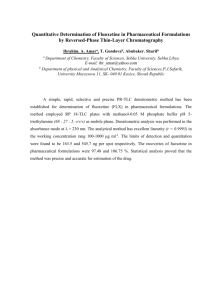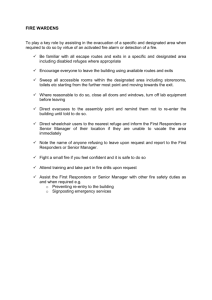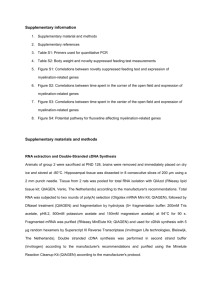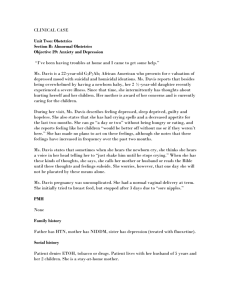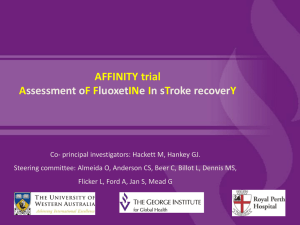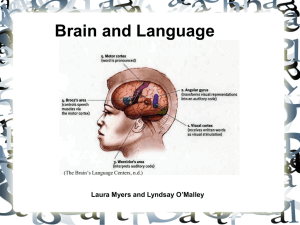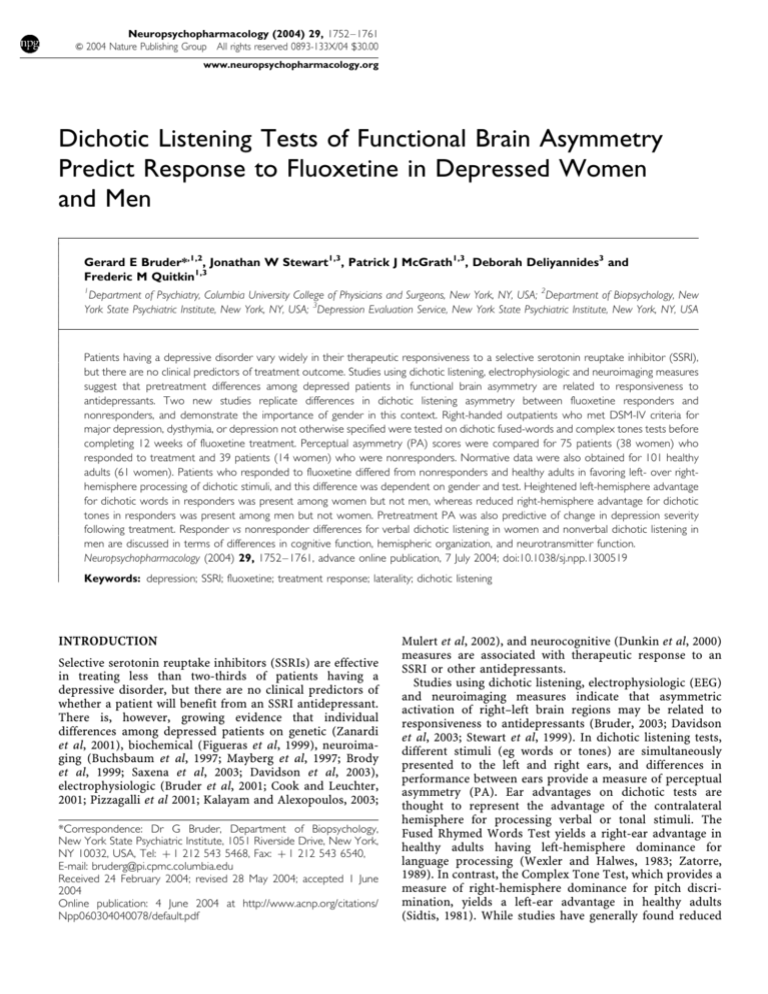
Neuropsychopharmacology (2004) 29, 1752–1761
& 2004 Nature Publishing Group All rights reserved 0893-133X/04 $30.00
www.neuropsychopharmacology.org
Dichotic Listening Tests of Functional Brain Asymmetry
Predict Response to Fluoxetine in Depressed Women
and Men
Gerard E Bruder*,1,2, Jonathan W Stewart1,3, Patrick J McGrath1,3, Deborah Deliyannides3 and
Frederic M Quitkin1,3
1
Department of Psychiatry, Columbia University College of Physicians and Surgeons, New York, NY, USA; 2Department of Biopsychology, New
York State Psychiatric Institute, New York, NY, USA; 3Depression Evaluation Service, New York State Psychiatric Institute, New York, NY, USA
Patients having a depressive disorder vary widely in their therapeutic responsiveness to a selective serotonin reuptake inhibitor (SSRI),
but there are no clinical predictors of treatment outcome. Studies using dichotic listening, electrophysiologic and neuroimaging measures
suggest that pretreatment differences among depressed patients in functional brain asymmetry are related to responsiveness to
antidepressants. Two new studies replicate differences in dichotic listening asymmetry between fluoxetine responders and
nonresponders, and demonstrate the importance of gender in this context. Right-handed outpatients who met DSM-IV criteria for
major depression, dysthymia, or depression not otherwise specified were tested on dichotic fused-words and complex tones tests before
completing 12 weeks of fluoxetine treatment. Perceptual asymmetry (PA) scores were compared for 75 patients (38 women) who
responded to treatment and 39 patients (14 women) who were nonresponders. Normative data were also obtained for 101 healthy
adults (61 women). Patients who responded to fluoxetine differed from nonresponders and healthy adults in favoring left- over righthemisphere processing of dichotic stimuli, and this difference was dependent on gender and test. Heightened left-hemisphere advantage
for dichotic words in responders was present among women but not men, whereas reduced right-hemisphere advantage for dichotic
tones in responders was present among men but not women. Pretreatment PA was also predictive of change in depression severity
following treatment. Responder vs nonresponder differences for verbal dichotic listening in women and nonverbal dichotic listening in
men are discussed in terms of differences in cognitive function, hemispheric organization, and neurotransmitter function.
Neuropsychopharmacology (2004) 29, 1752–1761, advance online publication, 7 July 2004; doi:10.1038/sj.npp.1300519
Keywords: depression; SSRI; fluoxetine; treatment response; laterality; dichotic listening
INTRODUCTION
Selective serotonin reuptake inhibitors (SSRIs) are effective
in treating less than two-thirds of patients having a
depressive disorder, but there are no clinical predictors of
whether a patient will benefit from an SSRI antidepressant.
There is, however, growing evidence that individual
differences among depressed patients on genetic (Zanardi
et al, 2001), biochemical (Figueras et al, 1999), neuroimaging (Buchsbaum et al, 1997; Mayberg et al, 1997; Brody
et al, 1999; Saxena et al, 2003; Davidson et al, 2003),
electrophysiologic (Bruder et al, 2001; Cook and Leuchter,
2001; Pizzagalli et al 2001; Kalayam and Alexopoulos, 2003;
*Correspondence: Dr G Bruder, Department of Biopsychology,
New York State Psychiatric Institute, 1051 Riverside Drive, New York,
NY 10032, USA, Tel: þ 1 212 543 5468, Fax: þ 1 212 543 6540,
E-mail: bruderg@pi.cpmc.columbia.edu
Received 24 February 2004; revised 28 May 2004; accepted 1 June
2004
Online publication: 4 June 2004 at http://www.acnp.org/citations/
Npp060304040078/default.pdf
Mulert et al, 2002), and neurocognitive (Dunkin et al, 2000)
measures are associated with therapeutic response to an
SSRI or other antidepressants.
Studies using dichotic listening, electrophysiologic (EEG)
and neuroimaging measures indicate that asymmetric
activation of right–left brain regions may be related to
responsiveness to antidepressants (Bruder, 2003; Davidson
et al, 2003; Stewart et al, 1999). In dichotic listening tests,
different stimuli (eg words or tones) are simultaneously
presented to the left and right ears, and differences in
performance between ears provide a measure of perceptual
asymmetry (PA). Ear advantages on dichotic tests are
thought to represent the advantage of the contralateral
hemisphere for processing verbal or tonal stimuli. The
Fused Rhymed Words Test yields a right-ear advantage in
healthy adults having left-hemisphere dominance for
language processing (Wexler and Halwes, 1983; Zatorre,
1989). In contrast, the Complex Tone Test, which provides a
measure of right-hemisphere dominance for pitch discrimination, yields a left-ear advantage in healthy adults
(Sidtis, 1981). While studies have generally found reduced
Dichotic listening and fluoxetine response
GE Bruder et al
1753
or absent right-hemisphere advantage in depressed patients
for nonverbal dichotic tests, findings for verbal tests have
been inconsistent (see Bruder, 1988 for a review), and some
studies have found a normal left-hemisphere advantage in
depressed patients for perceiving dichotic consonant–vowel
syllables (Hugdahl et al, 2003). Inconsistent findings may
reflect not only methodological differences, for example, use
of different dichotic tests, but also the clinical heterogeneity
of depressive disorders. It has been suggested that
differences among depressed patients on dichotic listening
tests may help to define pathologically distinct subtypes
(Wexler et al, 1989). Differences in dichotic listening PA
have been found between diagnostic subtypes of depression
(Bruder et al, 1989) and between patients who respond to a
tricyclic antidepressant and those who do not (Bruder et al,
1990).
In a prior study of the SSRI fluoxetine (Bruder et al,
1996), unmedicated depressed patients at two clinical
centers who subsequently responded to fluoxetine had
greater left-hemisphere advantage for dichotic fused words
and less right-hemisphere advantage for complex tones
when compared to treatment nonresponders. There was no
change in PA following treatment, which suggests that the
difference between fluoxetine responders and nonresponders represents a stable, state-independent characteristic.
These results supported the hypothesis that a characteristic
PA favoring left- over right-hemispheric activation during
dichotic listening is associated with favorable response to
fluoxetine, whereas the opposite hemispheric asymmetry
predicts poor response.
This report presents findings of two additional studies
that replicate differences in dichotic listening asymmetry
between fluoxetine responders and nonresponders, which is
of importance given the lack of findings replicating
predictors of treatment response (Joyce and Paykel, 1989;
Sotsky et al, 1991). One study included a 6-week placebo
lead-in period, providing some control over nonspecific
placebo response. Moreover, the relatively large sample of
patients in these studies allowed us to examine the role of
gender in this context. The greater prevalence of depression
among women (Weissman et al, 1984) and gender
differences in cognitive function and hemispheric organization point to the importance of examining this variable
(Heller, 1993). The tendency for women to perform better
on verbal tasks and men to perform better on spatial tasks
appears to be related to differences in hemispheric
specialization (Hiscock et al, 1995). Studies have found
evidence that the superiority of women for verbal processing results from their having bilateral activation of frontal
and temporal lobe regions involved in language processing,
whereas men are more left lateralized for verbal processing
(McGlone, 1980; Bryden, 1988; Shaywitz et al, 1995; Kimura,
1999; Kansaku et al, 2000). Gur et al (2000) found that men
also show more right-lateralized activation of inferior
parietal and temporal lobe regions during a visuospatial
task and tend to perform better when compared to women.
Gender differences have also been reported for serotonergic
function and it has been suggested that these differences are
related to the development of gender-related disorders such
as depression (Arato et al, 1991b; Steiner et al, 1997). Our
preliminary findings suggested that pretreatment differences between fluoxetine responders and nonresponders on
dichotic fused words and EEG asymmetry measures are
more evident among depressed women than men (Bruder
et al, 2001). We report below the findings for larger samples
from two studies that confirm the importance of gender in
this context.
METHODS
Patients
The patients were right-handed depressed outpatients
between the ages of 18 and 65 who were attending a
university-affiliated Depression Evaluation Service at New
York State Psychiatric Institute. Patients were excluded for
any of the following reasons: serious suicide risk, substance
abuse disorders (including alcohol abuse) within the last
6 months, psychotic disorders, antisocial personality disorder, seizure disorder, organic mental disorder, history of
head trauma, or other neurological disorder. Patients were
also excluded if they had a hearing loss greater than 30 dB in
either ear at 500, 1000, or 2000 Hz or if they had an ear
difference greater than 10 dB. All participants signed
informed consent forms before participating in the study.
The diagnostic assessment and treatment of patients were
carried out by research psychiatrists in the Depression
Evaluation Service. The patients were participants in two
treatment studies, for which preliminary findings were
presented for less than half of the samples in this report
(Bruder et al, 2001). In Study 1, 65 patients who met DSMIV criteria for major depressive disorder (MDD) were tested
during a 7–10 days single-blind placebo period and then
completed 12 weeks of fluoxetine treatment. This was an
open clinical trial and patients were therefore aware of
receiving active medication during the 12-week period.
Patients received 10 mg of fluoxetine during week 1, 20 mg
during weeks 2–4, and 40 mg during weeks 5–8, and if there
was still no response, a further increase to 60 mg was
permitted during weeks 9–12. In Study 2, 64 patients were
tested before receiving placebo for 6 weeks single-blind or
during the first week of placebo. Of these patients, 15
responded to placebo (see definition below). Only patients
who were placebo nonresponders received 12 weeks of
treatment with fluoxetine. Patients began fluoxetine treatment at 20 mg, and the dose was increased biweekly up to a
maximum of 80 mg depending on clinical need and
tolerance. The 49 patients who completed the 12 weeks of
fluoxetine treatment were more heterogeneous in their
diagnoses than the patients in Study 1, with eight meeting
DSM-IV criteria for MDD, 23 for dysthymia, seven for both
of these disorders (double depression), 11 for depression
not otherwise specified, and one for bipolar disorder. In
both studies, an independent evaluator, blind to the
patient’s dichotic listening data, rated each patient at the
end of 12 weeks of treatment using the Clinical Global
Impression Improvement (CGI-I) scale. Patients who had a
CGI-I rating of ‘much improved’ or ‘very much improved’
were considered to be responders and all other patients
were considered as nonresponders.
Table 1 gives the characteristics of the 75 patients who
were classified as fluoxetine responders and the 39 patients
who were nonresponders. There was approximately equal
numbers of women and men in the responder group, but a
Neuropsychopharmacology
Dichotic listening and fluoxetine response
GE Bruder et al
1754
Table 1 Characteristics of Treatment Responders and
Nonresponders
Responders
Nonresponders
Women
Men
Women
Men
38
37
14
25
n
Age (years)
M
36.0
41.2
36.1
38.4
SD
12.4
11.3
14.3
11.1
few patients had anxiety disorders to include this as a
variable, analyses of the dichotic listening data were
repeated after excluding patients having a comorbid anxiety
disorder, and the results were essentially the same as
reported below for the full samples. There was no difference
among groups in pretreatment severity of depressive
symptoms, as measured by the Hamilton Rating Scale
(HAM-D21). Following treatment, both women and men
who responded to treatment had markedly lower HAM-D21
scores than nonresponders (F ¼ 144.43, df ¼ 1,109,
po0.001).
Healthy Adults
Education (years)
M
15.4a
15.8b
14.8
15.2
SD
2.3
2.5
2.8
2.4
M
83.0
80.6
94.3
92.5
SD
19.4
18.4
9.5
10.7
84.2
59.4
85.7
52.0
13.2
8.1
35.7
24.0
Handedness (LQ)
Major depressive disorderc
%
Anxiety disorderd
%
Pretreatment HAM-D-21
Dichotic Listening Tests
M
15.8
14.8
16.0
14.7
SD
4.4
5.7
5.4
6.2
Post-treatment HAM-D-21e
M
4.4
3.8
15.0
13.0f
SD
2.8
3.1
4.9
5.9
a
n ¼ 37.
n ¼ 35.
c
Men differ significantly from women, w2 ¼ 10.54, df ¼ 1, po0.01.
d
Responders differ significantly from nonresponders, w2 ¼ 5.67, df ¼ 1, po0.05.
e
Responders differ significantly from nonresponders, F ¼ 144.43, df ¼ 1,109,
po0.001.
f
n ¼ 24.
b
somewhat smaller proportion of nonresponders were
women, and therefore gender was included as a variable
in statistical analyses. An analysis of variance (ANOVA)
with treatment response as one variable and gender as a
second variable did not reveal a significant difference
among groups in age or education. All patients were right
handed, as indicated by their positive laterality quotient
(LQ) on the Edinburgh Handedness Inventory (Oldfield,
1971). The percentage of patients meeting criteria for MDD
did not differ between responders and nonresponders, but
fewer men in each group had an MDD when compared to
women (w2 ¼ 10.54, df ¼ 1, po0.01). Nonresponders differed from responders in having a higher percentage with
comorbid anxiety disorders, that is, primarily social phobia
or panic disorders (w2 ¼ 5.67, df ¼ 1, po0.05). Although too
Neuropsychopharmacology
Normative data for the Fused Rhymed Words Test and the
Complex Tone Test were obtained for 101 right-handed
healthy adults (61 women, 40 men). These healthy adults
were screened to exclude those having psychopathology,
substance abuse, history of head trauma, neurological
disorder, hearing loss greater than 30 dB in either ear at
500, 1000, or 2000 Hz, or an ear difference greater than
10 dB. The mean age of the healthy women was 30.0
(SD ¼ 8.8) and that of the men was 31.3 (SD ¼ 7.6).
Although their mean age is somewhat younger than for
the patient groups, age was not significantly related to their
PA scores on either the fused-words (r ¼ 0.16, NS) or
complex tones (r ¼ 0.03, NS) tests, nor was education level
significantly associated with PA scores for these tests.
Patients were unmedicated a minimum of 7 days before
testing, although most patients were drug free for
a considerably longer period or were not previously treated
with an antidepressant. No patient was tested within
6 weeks of receiving fluoxetine or 2 weeks of receiving
other antidepressants. All patients were tested on the
dichotic fused-words and complex tones tests described
below, with the order of the tests counterbalanced across
patients.
The Fused Rhymed Words Test (Wexler and Halwes,
1983) consists of 15 different single-syllable word pairs in
which each member of every pair differs from the other only
in the initial consonant (eg coat, goat). All words begin with
one of six stop consonants (b, d, p, t, g, k) and are natural
speech spoken by a male voice. When presented dichotically, the members of each pair fuse into a single percept.
Participants indicate what word they heard by marking a
line through it on a prepared answer sheet that has four
possible responses, both members of the dichotic pair and
two other words differing from the dichotic stimuli only in
the initial consonant. Following practice trials, each
participant received four 30-item blocks for a total of 120
trials. Orientation of headphones was reversed after the first
and third quarters to control for channel differences and ear
of presentation. The words were presented via a matched
pair of TDH-49 headphones at a comfortable level of 75 dB
sound pressure level (SPL).
The Complex Tone Test (Sidtis, 1981) requires participants to compare the pitch of a binaural complex tone with
the pitches of a dichotic pair of complex tones presented 1 s
earlier. Subjects point to a response card labeled Yes when
Dichotic listening and fluoxetine response
GE Bruder et al
1755
the probe tone is the same as either member of the previous
dichotic pair or to a card labeled No when it differs from
both. The complex tones are square waves with fundamental frequencies corresponding to eight notes in the
octave between C4 and C5. After 16 binaural and 16 dichotic
practice trails, participants were tested on four blocks of 28
trials in which half of the probe tones matched a member of
the dichotic pair and half did not. Orientation of headphones was reversed after the first and third blocks. The
tones were presented at 74 dB SPL.
Statistical Analyses
The number of correct responses in the fused-words and
complex tones tests was computed for right- and left-ear
presentations. These scores were used to compute a
measure of PA for each task, where PA ¼ 100(Right
CorrectLeft Correct)/(Right Correct þ Left Correct). A
2 2 2 2 ANOVA of PA scores included the betweensubject variables of Treatment Response (responder, nonresponder), Gender (women, men) and Treatment Study
(1, 2), and one repeated-measure factor of Test (words,
tones). Differences between responders and nonresponders
on each test were examined with t-tests. Two additional
ANOVA of PA scores were computed: (1) to control for
possible effects of anxiety disorders, a 2 (Treatment
Response) 2 (Gender) 2 (Test) ANOVA was computed
including only the 67 fluoxetine responders and 28
nonresponders without an anxiety disorder; and (2) to
assess placebo effects, this 2 2 2 ANOVA compared the
PA scores for 15 patients (four women) in Study 2 who
responded to 6 weeks of placebo and 49 patients (14
women) who were placebo nonresponders.
In order to examine whether group differences in
PA scores on the Complex Tone Test were due to
differences in left-ear accuracy, right-ear accuracy, or
both, absolute accuracy scores for tones presented to the
left and right ears were analyzed using an ANOVA with
between-subject variables of Group (responder, nonresponder, controls) and Gender (women, men), and the repeatedmeasure Ear (left, right). No analyses of accuracy data for
the fused-words test were performed because the members
of the dichotic pair fuse into a single percept and subjects
are essentially 100% correct for reporting the word heard in
either ear.
The potential value of PA scores on the dichotic tests
for predicting therapeutic response to fluoxetine in women
and men was examined using w2-tests to compare
the response rate of patients with PA scores above vs below
the mean score for healthy adults. Sensitivity, specificity,
positive predictive value, and negative predictive value
were computed separately for women and men.
The predictive significance of the dichotic listening tests
was also examined with logistic regression analyses,
in which PA scores for the word and tone tests were
included in a linear model predicting response to fluoxetine.
After controlling for baseline ratings of symptom severity
on the HAM-D21, correlations were computed to determine
whether pretreatment PA scores were associated with
changes in HAM-D21 ratings after 12 weeks of fluoxetine
treatment.
RESULTS
Figure 1 shows the PA scores for treatment responders and
nonresponders in Study 1 and 2. The arrows show the mean
left-hemisphere advantage for words (ie positive PA scores)
and right-hemisphere advantage for tones (ie negative PA
scores) for healthy adults (HA). The responders and
nonresponders also showed the expected difference in PA
for words and tones (F ¼ 146.90, df ¼ 1,106, po0.001). In
both studies, responders had a larger left-hemisphere
advantage for words and a smaller right-hemisphere
advantage for tones when compared to nonresponders.
The common direction of this group difference in
asymmetry for words and tones was reflected in a main
effect of Treatment Response (F ¼ 8.69, df ¼ 1,106,
po0.005). The magnitude of the difference in PA between
responders and nonresponders was essentially the same
across studies, which is supported by the lack of a
significant main effect or interaction involving the Study
variable.
The difference in asymmetry between responders and
nonresponders on each test was, however, dependent on
gender, as indicated by a Treatment Response Gender
Test interaction (F ¼ 10.72, df ¼ 1,106, p ¼ 0.001). The
nature of this interaction is illustrated in Figure 2, which
shows the PA scores for responders and nonresponders
plotted separately for women and men. The data in this
figure were averaged across studies because the Treatment
Response Gender Test interaction was equally evident
in Study 1 (F ¼ 5.54, df ¼ 1,61, po0.05) and Study 2
(F ¼ 5.17, df ¼ 1,45, po0.05). On the words test, the
tendency for responders to have a larger left-hemisphere
advantage than nonresponders was evident for women but
not for men. The mean left-hemisphere advantage for
women who responded to fluoxetine was about three times
as large as seen for nonresponders (t ¼ 4.48, df ¼ 50,
po0.001), but there was no significant difference in the
left-hemisphere advantage for words between male respon-
Figure 1 Mean PA scores on dichotic fused-words and complex tones
tests for fluoxetine responders and nonresponders in two studies. PA
score ¼ 100(RL)/(R þ L), where R ¼ right-ear accuracy and L ¼ left-ear
accuracy. HA ¼ mean PA scores for 101 healthy adults.
Neuropsychopharmacology
Dichotic listening and fluoxetine response
GE Bruder et al
1756
Table 2 Percent Correct for Complex Tones in Left and Right Ear
for Responders, Nonresponders, and Healthy Adults
Responders
Nonresponders
Healthy adults
Women
Men
Women
Men
Women
Men
38
37
14
25
61
40
M
87.8a
85.0
91.8b
89.0c
90.4d
88.2e
SD
9.3
14.7
9.8
10.0
10.5
9.7
M
80.0a
83.1f
82.4b
80.8c,f
83.2d
73.1e,f
SD
15.1
13.7
15.2
17.2
13.8
18.7
n
Left ear
Right ear
Figure 2 Mean PA scores on dichotic fused-words and complex tones
tests for women and men fluoxetine responders and nonresponders
averaged over studies. PA score ¼ 100(RL)/(R þ L), where R ¼ right-ear
accuracy and L ¼ left-ear accuracy. HW ¼ mean PA scores for 61 healthy
women and HM ¼ mean PA scores for 40 healthy men.
ders and nonresponders. Women who responded to
fluoxetine also had significantly larger left-hemisphere
advantage for words when compared to healthy women
(arrow labeled HW in Figure 2; t ¼ 3.16, df ¼ 97, po0.005).
Female nonresponders tended to have a smaller lefthemisphere advantage for words relative to healthy women,
but this difference was not statistically significant, nor was
there a significant difference in the left-hemisphere
advantage for words between male responders or nonresponders and healthy men (arrow labeled HM in Figure 2).
On the complex tones test, the tendency for responders to
have a smaller right-hemisphere advantage than nonresponders was evident for men but not women. Men who
responded to fluoxetine had significantly smaller righthemisphere advantage for tones when compared to either
male nonresponders (t ¼ 2.20, df ¼ 60, po0.05) or healthy
men (t ¼ 4.56, df ¼ 75, po0.001). In contrast, there was no
significant difference in right-hemisphere advantage for
tones between women responders and nonresponders or
between these groups and healthy women; nor was there a
significant difference in right-hemisphere advantage between male nonresponders and healthy men.
Absolute accuracy scores for perceiving complex tones in
the left or right ear are given in Table 2 for responders,
nonresponders, and healthy adults. An ANOVA of these
accuracy scores revealed a significant Group Gender
Ear interaction (F ¼ 5.39, df ¼ 2,209, p ¼ 0.005). Men
who responded to fluoxetine failed to show the significant
left-ear (right-hemisphere) advantage seen for the other
groups of men and women. These accuracy data also
suggest that the reduced right-hemisphere advantage in
male responders was due, at least in part, to their better
right-ear (left-hemisphere) accuracy. There was a signifiNeuropsychopharmacology
a
Left-ear accuracy significantly greater than right-ear accuracy, t ¼ 3.59, df ¼ 37,
P ¼ 0.001.
b
Left-ear accuracy significantly greater than right-ear accuracy, t ¼ 2.32, df ¼ 13,
po0.05.
c
Left-ear accuracy significantly greater than right-ear accuracy, t ¼ 2.68, df ¼ 24,
p ¼ 0.01.
d
Left-ear accuracy significantly greater than right-ear accuracy, t ¼ 4.09, df ¼ 60,
po0.001.
e
Left-ear accuracy significantly greater than right-ear accuracy, t ¼ 6.04, df ¼ 39,
po0.001.
f
Significant difference among men in the right-ear accuracy, F ¼ 3.73, df ¼ 2,99,
po0.05, with responders4healthy adults.
cant difference in right-ear accuracy among the male groups
(F ¼ 3.73, df ¼ 2,101, po0.05), with male responders showing better performance compared to healthy men (po0.05),
and nonresponders showing an intermediate accuracy level.
In contrast, differences in left-ear accuracy among men, or
differences in left- or right-ear accuracy among women,
were not statistically significant.
When the PA data were reanalyzed including only
fluoxetine responders and nonresponders without a comorbid anxiety disorder, the findings were essentially the same
as reported above for the full sample. An ANOVA of the
data for these patients yielded the same main effect of
Treatment Response (F ¼ 13.08, df ¼ 1,91, po0.001) and a
Treatment Response Gender Test interaction (F ¼ 5.79,
df ¼ 1,91, po0.05). These effects were not, however, evident
in an analysis of the PA data for the 15 placebo responders
and 49 placebo nonresponders in Study 2. An ANOVA of
their data did not yield a significant main effect of
Treatment Response (F ¼ 0.53, df ¼ 1,60, p ¼ 0.47) or
interactions involving gender. The left-hemisphere advantage for words was not different in placebo responders
(M ¼ 8.95, SD ¼ 17.24) and nonresponders (M ¼ 13.88,
SD ¼ 15.2), nor was there a difference in the right-hemisphere advantage for tones between placebo responders
(M ¼ 3.20, SD ¼ 6.39) and nonresponders (M ¼ 3.34,
SD ¼ 9.38). Thus, they showed no evidence of the difference
in PA seen between fluoxetine responders and nonresponders.
Inspection of the distributions of PA scores on the fusedwords test for women who were fluoxetine responders or
nonresponders (left portion of Figure 3) suggests its value
Dichotic listening and fluoxetine response
GE Bruder et al
1757
Table 3 Indices Evaluating Predictions of Response Using
Fused-Words Test for Women and Complex Tone Test for Men
WomenFfused words
MenFcomplex tones
Study 1
72.4
94.4
Study 2
88.9
94.7
Total
76.3
94.6
Sensitivitya
Specificityb
Study 1
77.8
22.2
Study 2
100
25.0
Total
85.7
24.0
Positive predictive valuec
Study 1
91.3
70.8
Study 2
100
60.0
Total
93.5
64.8
Study 1
46.7
66.7
Study 2
83.3
80.0
Total
57.1
75.0
Negative predictive valued
a
Figure 3 PA scores for individual women fluoxetine responders and
nonresponders, and mean PA score for 61 healthy women (HW) on the
fused-words test (left portion of the figure); PA scores for individual men
fluoxetine responders and nonresponders, and mean PA score for 40
healthy men (HM) on the complex tone test (right portion of the figure).
Closed circles represent Study 1 and open circles Study 2.
Sensitivity ¼ percentage of responders who were predicted to be responders.
Specificity ¼ percentage of nonresponders who were predictive to be
nonresponders.
c
Positive predictive value ¼ response rate for patients who were predicted to be
responders.
d
Negative predictive value ¼ nonresponse rate for patients who were predicted
to be nonresponders.
for predicting outcome of treatment. This figure also
illustrates the agreement of the PA data across Study 1
(solid circles) and Study 2 (open circles). As in the past
(Bruder et al, 2001), we used the mean PA score for healthy
women (arrow labeled HW in Figure 3) as a cutoff score for
dividing patients into those with relatively large vs small
left-hemisphere advantage, and a comparison was made of
their treatment response. Of the 32 women with a lefthemisphere advantage above the normal mean, 29 responded to fluoxetine (ie a 94% response rate), whereas
only nine of 21 women with a left-hemisphere advantage
less than normal responded to fluoxetine (ie a 43% response
rate; w2 ¼ 16.30, df ¼ 1, po0.001). Using this cutoff score to
predict fluoxetine response among women, the fused-words
test had a relatively high sensitivity, specificity, and positive
predictive value in both Study 1 and 2 (see Table 3). The
negative predictive value was higher in Study 2 than in
Study 1, which may stem from the longer placebo period in
Study 2. Thus, the 6-week placebo lead-in might be expected
to reduce the number of patients who are predicted to be
fluoxetine nonresponders (ie PA score below normal mean),
but who have a nonspecific, ‘placebo’ response during
active treatment (see left portion of Figure 3).
Women with a left-hemisphere advantage for words
above the normal mean had considerably greater response
rate to fluoxetine than would be expected to occur on
placebo. Only one of nine women with a left-hemisphere
advantage above the normal mean responded to 6 weeks of
placebo (ie a response rate of 11%), which is significantly
smaller than the 94% response rate to fluoxetine for women
who had above normal left-hemisphere advantage
(w2 ¼ 25.27, df ¼ 1, po0.001). In contrast, the 43% response
rate to fluoxetine for women with a left-hemisphere
advantage below the normal mean is not significantly
different from the 33% response rate to placebo (ie three of
nine) for women having below normal left-hemisphere
advantage.
The PA scores for women on the dichotic fused-words
and complex tones tests were also examined as combined
and individual predictors of fluoxetine response in hierarchical logistic regression equations. The two asymmetry
scores significantly improved prediction of treatment outcome over a constant alone (w2 ¼ 13.75, df ¼ 1, po0.001).
Asymmetry for the fused-words test was a significant
predictor of treatment outcome on its own (Wald
test ¼ 8.67, df ¼ 1, po0.005), but the tone test did not
contribute significant additional prediction over the asymmetry for the words test. The magnitude of left-hemisphere
advantage for words among women was also found to
predict the reduction in symptom severity on the HAM-D21
following 12 weeks of fluoxetine treatment. HAM-D21
ratings at baseline were not significantly related to PA
b
Neuropsychopharmacology
Dichotic listening and fluoxetine response
GE Bruder et al
1758
scores for either words or tones. Controlling for baseline
HAM-D21 ratings, the change in ratings following 12 weeks
of treatment was significantly correlated with baseline PA
scores for words (r ¼ 0.32, po0.05), but not tones
(r ¼ 0.04, NS). Thus, women with larger left-hemisphere
advantage for words at baseline showed least severe
symptoms after 12 weeks of treatment.
The right portion of Figure 3 shows the distribution of PA
scores for men on the complex tone test, which significantly
discriminated between responders and nonresponders. Men
who responded to fluoxetine showed essentially no asymmetry (ie a mean PA score close to zero), whereas
nonresponders tended to show the expected right-hemisphere advantage for tones. The mean PA score for healthy
men (arrow labeled HM in Figure 3) was used as a cutoff
score for dividing male patients into those with a PA score
above vs below the normal mean for tones. Patients with a
PA score above the normal mean had a 65% response rate
(ie 35 of 54 of these men were responders), whereas patients
with a PA below the normal mean had only a 25% response
rate (ie two of eight of these men were responders) to
fluoxetine (w2 ¼ 4.59, df ¼ 1, po0.05). Using this cutoff
score to predict fluoxetine response among men, the
complex tone test had high sensitivity but low specificity
(Table 3), which is due to the mean PA score for healthy
men being low (ie more negative) relative to the distribution
of scores for patients (see right portion of Figure 3). The
positive and negative predictive values were, however,
moderately high for predicting response to fluoxetine
among men.
Men with a PA score for complex tones above the normal
mean had a higher response rate on fluoxetine than would
be expected on placebo. Only nine or 39 men who had a PA
score above the normal mean responded to 6 weeks of
placebo (ie a response rate of 23%), which is significantly
smaller than the 65% response rate to fluoxetine in men
who had a PA score above the normal mean (w2 ¼ 15.86,
df ¼ 1, po0.001). Although sample sizes are small, men with
a PA score below the normal mean did not differ in
response rate on fluoxetine (25%; two of eight were
responders) as compared to placebo (29%; two of seven
were responders).
The PA scores for men on the fused-words and complex
tones tests were also examined as combined and individual
predictors of fluoxetine response in hierarchical logistic
regression equations. The two asymmetry scores significantly improved prediction of treatment outcome over a
constant alone (w2 ¼ 4.85, df ¼ 1, po0.05). Asymmetry
scores for men on the complex tone test was a significant
predictor of treatment outcome on its own (Wald
test ¼ 4.06, df ¼ 1, po0.05), but the words test did not
contribute significant additional prediction over the asymmetry for the tone test. The right-hemisphere advantage for
complex tones among men was also found to predict the
change in symptom severity on the HAM-D21 following 12
weeks of fluoxetine treatment. When controlling for baseline HAM-D21 ratings, the change in ratings after 12 weeks
of treatment was correlated with baseline PA scores for
tones (r ¼ 0.43, p ¼ 0.001), but not for words (r ¼ 0.05,
NS). Thus, men with little or no right-hemisphere advantage
for tones (ie less negative or a positive PA score) showed the
least severe symptoms after 12 weeks of treatment.
Neuropsychopharmacology
DISCUSSION
Differences among depressed patients in hemispheric
asymmetry of function, as measured by dichotic listening
tests, are predictive of therapeutic response to the SSRI
fluoxetine. Patients who respond to fluoxetine differed from
nonresponders in favoring left- over right-hemisphere
processing of dichotic stimuli. Fluoxetine responders had
overall greater left-hemisphere advantage for words and less
right-hemisphere advantage for complex tones when
compared to nonresponders. This was the case in two
separate studies, one with patients having an MDD and the
other with patients having a mixture of affective disorders,
including MDD, dysthymia, or depression not otherwise
specified. The consistency of findings across these studies
and our prior study (Bruder et al, 1996) indicates that the
difference in hemispheric asymmetry between fluoxetine
responders and nonresponders is robust and replicable.
The difference in hemispheric asymmetry between
fluoxetine responders and nonresponders was dependent
on gender. Although women and men who responded to
fluoxetine exhibited the same direction of asymmetry,
favoring of left- over right-hemisphere processing, it was
manifested on the verbal test in women but on the
nonverbal test in men. Thus, the tendency for responders
to have heightened left-hemisphere advantage for words
was evident among women but not men, whereas the
tendency for responders to have reduced or no righthemisphere advantage for tones was evident among men
but not women. The abnormally large left-hemisphere
advantage for words in women who responded to fluoxetine
is the predominant PA seen among depressed adults and
adolescents on the fused-words test (Pine et al, 2000; Bruder
et al, 2004). In contrast, women who failed to respond to
fluoxetine had a relatively small left-hemisphere advantage
for words that did not differ significantly from healthy
women. In men, differences between responders and
nonresponders on the complex tone test were less marked
than seen for women on the fused-words test. While
depressed men who responded to fluoxetine had little or no
right-hemisphere advantage for complex tones, nonresponders showed a right-hemisphere advantage that did not
differ significantly from healthy men. Thus, the women and
men who respond to fluoxetine show abnormal hemispheric
asymmetries, which are not seen in nonresponders.
What might account for the finding of responder vs
nonresponder differences on the verbal test in women, but
the nonverbal test in men? Heller (1993) speculated on the
relation of gender differences in cognitive function and
hemispheric organization to gender differences in depression. A maturational advantage of the left hemisphere
among girls and right hemisphere among boys may lead to
the development of tendencies for women to favor verbal
strategies and men to favor nonverbal strategies. Women
may therefore be more likely to ruminate when depressed,
which would involve increased activation of left frontotemporal regions involved in verbal processing. One form of
depression among women, which responds to an SSRI
antidepressant, may be characterized by relatively greater
activation of these left-hemisphere regions. The reduced
right-hemisphere advantage for nonverbal dichotic listening
in men who responded to fluoxetine agrees with that
Dichotic listening and fluoxetine response
GE Bruder et al
1759
generally reported for depressed adults (Bruder et al, 1989;
Overby et al, 1989), but this abnormality does appear to be
more evident in depressed men than women (Bruder et al,
2004). The absolute accuracy data for the complex tone
dichotic test indicate that the reduced right-hemisphere
advantage in men who responded to fluoxetine was due to
their better than normal performance for right-ear tones.
Given the predominantly contralateral projections from ear
to auditory cortex, this finding is more suggestive of lefthemisphere hyperactivation than right-hemisphere dysfunction. Thus, the findings for both men and women
support the hypothesis that heightened left-hemisphere
processing of dichotic stimuli is associated with favorable
response to fluoxetine.
An important question that needs further study is why
individual differences in hemispheric asymmetry among
depressed patients are related to therapeutic responsiveness
to an SSRI antidepressant? One possible reason is that the
serotonin neurotransmitter system implicated in depressive
disorders and affected by SSRI antidepressants may have a
lateralized distribution in the brain or may be asymmetrically disrupted in a subtype of depression that responds
to an SSRI. Although it has been suggested that the
serotonin neurotransmitter system is asymmetrically distributed in the brain (Mandell and Knapp, 1979; Tucker and
Williamson, 1984), the findings of postmortem studies have
been inconsistent (Arato et al, 1991a; Arora and Meltzer,
1991). Neuroimaging studies have provided evidence that
individual differences among depressed patients in regional
brain activity are related to subsequent response to an SSRI
or other antidepressants (Buchsbaum et al, 1997; Mayberg
et al, 1997; Brody et al, 1999; Hoehn-Saric et al, 2001;
Saxena et al, 2003; Davidson et al, 2003). Relatively greater
activity of the left rectal gyrus (Buchsbaum et al, 1997),
anterior cingulate (Davidson et al, 2003), or prefrontal
regions (Hoehn-Saric et al, 2001) was reported to be
predictive of favorable response to antidepressants.
Although the relation of these neuroimaging findings to
our dichotic listening findings is unclear, they do raise the
intriguing possibility that the favoring of left-hemisphere
processing of dichotic stimuli in fluoxetine responders may
reflect relatively greater left-sided activation in these
regions.
The responder vs nonresponder dichotomy has proven
useful for demonstrating the relation of pretreatment
differences in brain function and therapeutic responsiveness to antidepressants. Moreover, patients who respond to
a specific antidepressant, in this case the SSRI fluoxetine,
are likely to be more homogeneous in their etiology and
biological characteristics. Thus, SSRI responders may have
an abnormality of the serotonergic neurotransmitter system
that is not shared by patients who do not respond to an
SSRI. Our current findings and those of prior studies
support the existence of treatment-responsive and -nonresponsive subtypes of depression that differ in functional
brain asymmetry (Bruder et al, 1990, 1996; Stewart et al,
1999).
Our findings also suggest the possible clinical value of
dichotic listening tests for predicting therapeutic response
to an SSRI. The potential value of dichotic listening tests, as
opposed to electrophysiologic or neuroimaging tests, is that
they are easy and inexpensive to administer in an office or
clinical setting. The dichotic fused-words test (Wexler and
Halwes, 1983) shows particular promise as a clinical aid for
identifying depressed women who are likely to benefit from
treatment with the SSRI fluoxetine. Women with above
normal left-hemisphere advantage on the fused-words test
had a 94% response rate to fluoxetine, but only an 11%
response rate to placebo. In addition to its high sensitivity
and positive predictive value, the fused-words test also
demonstrated its value for identifying women who are not
likely to benefit from treatment with fluoxetine. Among
women who received dichotic tests, 27% failed to respond to
fluoxetine and another 22% responded to placebo. This
suggests that up to half of the women should not have been
treated with fluoxetine. If instead of treating all women with
fluoxetine we applied the fused-words test and gave
fluoxetine only to those with above normal left-hemisphere
advantage, only 6% would fail to respond to fluoxetine and
their expected placebo response rate would be 11%. Thus,
the number of women who would be unnecessarily treated
with this SSRI would be reduced from 49 to 17%. Moreover,
in those women with below normal left-hemisphere
advantage for words, the response rate to fluoxetine (43%)
is not likely to be any better than to placebo (33%). The
potential value of the fused-words test for identifying
women who are unlikely to respond to fluoxetine is
important because they may become increasingly hopeless
when they fail to benefit from this SSRI and drop out before
receiving an appropriate alternative treatment.
Although differences between responders and nonresponders were less marked for men, those with less than normal
right-hemisphere advantage on the complex tones test were
more than twice as likely to respond to fluoxetine than men
who had a greater than normal right-hemisphere advantage.
The complex tone test had excellent sensitivity for
predicting treatment response in men, but its predictive
value is weakened by low specificity. Pretreatment dichotic
listening performance was predictive of the change in
severity of depressive symptoms following fluoxetine
treatment. Men with less right-hemisphere advantage for
tones and women with greater left-hemisphere advantage
for words had the least severe symptoms after 12 weeks of
treatment. Further study of the value of dichotic listening
tests in clinic settings should be performed to demonstrate
prospectively its utility as an aid for selecting treatments
that will most benefit individual patients.
Lastly, there are several limitations or questions that
should be discussed. First, a higher proportion of nonresponders than responders had a comorbid anxiety
disorder. This is not unexpected given findings of poorer
treatment outcome in depressed patients having a comorbid
anxiety disorder (Fava et al, 1997; Frank et al, 2000). The
comorbidity difference is not likely to be a critical factor
because the difference in asymmetry between responders
and nonresponders remained the same when patients
having comorbidity were excluded from analyses. Second,
one could question whether the gender differences in
dichotic listening for responders and nonresponders might
be related to the fewer men than women with an MDD.
There was, however, no difference between responders and
nonresponders in MDD diagnoses. Also, all men and
women in Study 1 met criteria for MDD, and gender
differences for responders and nonresponders were the
Neuropsychopharmacology
Dichotic listening and fluoxetine response
GE Bruder et al
1760
same as seen for the full samples. Third, a question could be
raised as to whether our findings reflect response to
fluoxetine or a nonspecific placebo response? In Study 2,
only patients who did not respond to 6 weeks of placebo
received treatment with fluoxetine. Although the sample of
placebo responders in that study was relatively small, they
did not show differences in dichotic listening when
compared to placebo nonresponders. Moreover, patients
with PA scores above the normal mean, who were predicted
to respond to fluoxetine, had a response rate on fluoxetine
that was considerably greater than the response rate on
placebo. Thus, it is unlikely that the findings for fluoxetine
responders reflect a nonspecific placebo response. Lastly,
dichotic listening tests yield only limited information
concerning relative differences in hemispheric asymmetry.
Future studies should also use electrophysiologic or
neuroimaging measures to provide more direct measures
of regional hemispheric activation in treatment-responsive
and -nonresponsive subgroups.
ACKNOWLEDGEMENTS
This research was supported in part by National Institute of
Mental Health Grants MH36295 and MH56058. We thank
Donald F Klein for his helpful comments on a prior draft of
this manuscript, and Pual Leite, Barbara Stuart, Mia Sage,
and Carlye Griggs for their help with data collection and
processing.
REFERENCES
Arato M, Frescksa E, MacGrimmon DJ, Guscott R, Saxena B, Tekes
K et al (1991a). Serotonergic interhemispheric asymmetry:
neurochemical and pharmaco-EEG evidence. Prog Neuropsychopharmacol Biol Psychiatry 15: 759–764.
Arato M, Frecska E, Tekes K, MacCrimmon DJ (1991b).
Serotonergic interhemispheric asymmetry: gender difference in
the orbital cortex. Acta Psychiatr Scand 84: 110–111.
Arora RC, Meltzer HY (1991). Laterality and 3H-imipramine
binding: studies in the frontal cortex of normal controls and
suicide victims. Biol Psychiatry 29: 1016–1022.
Brody AL, Saxena S, Silverman DHS, Alborzian S, Fairbanks LA,
Phelps ME et al (1999). Brain metabolic changes in major
depressive disorder from pre- to post-treatment with paroxetine.
Psychiatry Res Neuroimag 91: 127–139.
Bruder G (2003). Frontal and parietotemporal asymmetries in
depressive disorders: behavioral, electrophysiologic, and neuroimaging findings. In: Hugdahl K, Davidson RH (eds). The
Asymmetrical Brain. MIT Press: Cambridge, MA. pp 719–742.
Bruder GE (1988). Dichotic listening in psychiatric patients. In:
Hugdahl K (ed). Handbook of Dichotic Listening: Theory,
Methods and Research. Wiley: New York, NY. pp 661–691.
Bruder GE, Otto MW, Stewart JW, McGrath P, Fava M, Rosenbaum
JF et al (1996). Dichotic listening before and after fluoxetine
treatment for major depression: relations of laterality to
therapeutic response. Neuropsychopharmacology 15: 171–179.
Bruder GE, Quitkin FM, Stewart JW, Martin C, Voglmaier M,
Harrison WM (1989). Cerebral laterality and depression:
differences in perceptual asymmetry among diagnostic subtypes.
J Abnorm Psychol 98: 177–1986.
Bruder GE, Schneier FR, Stewart JW, McGrath PJ, Quitkin F (2004).
Left hemisphere dysfunction during verbal dichotic listening
tests in patients who have social phobia with or without
comorbid depressive disorder. Am J Psychiatry 161: 72–78.
Neuropsychopharmacology
Bruder GE, Stewart JW, Tenke CE, McGrath PJ, Leite P,
Bhattacharya N et al (2001). Electroencephalographic and
perceptual asymmetry differences between responders and
nonresponders to an SSRI antidepressant. Biol Psychiatry 48:
416–425.
Bruder GE, Stewart JW, Voglmaier MM, Harrison WM, McGrath P,
Tricamoo E et al (1990). Cerebral laterality and depression:
relations of perceptual asymmetry to outcome of treatment with
tricyclic antidepressants. Neuropsychopharmcology 3: 1–10.
Bryden MP (1988). An overview of the dichotic listening procedure
and its relation to cerebral organization. In: Hugdahl K (ed).
Handbook of Dichotic Listening: Theory, Methods and Research.
Wiley: Chichester, UK. pp 1–43.
Buchsbaum MS, Wu J, Siegel BV, Hackett E, Trenary M, Abel L et al
(1997). Effect of sertraline on regional metabolic rate in patients
with affective disorder. Biol Psychiatry 41: 15–22.
Cook IA, Leuchter AF (2001). Prefrontal changes and treatment
response prediction in depression. Semin Clin Neuropsychiatry
6: 113–120.
Davidson RJ, Irwin W, Anderle MJ, Kalin NH (2003). The neural
substrates of affective processing in depressed patients treated
with venlafaxine. Am J Psychiatry 160: 64–75.
Dunkin JJ, Leuchter AF, Cook IA, Kasi-Godey JE, Abrams M,
Rosenberg-Thompson S (2000). Executive dysfunction predicts
nonresponse to fluoxetine in major depression. J Affect Disord
60: 13–23.
Fava M, Uebelacker LA, Alpert JE, Nierenberg AA, Pava JA,
Rosenbaum JF (1997). Major depressive subtypes and treatment
response. Biol Psychiatry 42: 568–576.
Figueras G, Perez V, San Martino O, Alvarez E, de Trastornos
Afectivos G, Artigas F (1999). Pretreatment platelet 5-HT
concentration predicts the short-term response to paroxetine
in major depression. Biol Psychiatry 46: 518–524.
Frank E, Shear MK, Rucci P, Cyranoswki JM, Endicott J, Fagiolini
A et al (2000). Influence of panic–agroraphobic spectrum
symptoms on treatment response in patients with recurrent
major depression. Am J Psychiatry 157: 1101–1107.
Gur RC, Alsop D, Glahn D, Petty R, Swanson CL, Maldjian JA et al
(2000). An fMRI study of sex differences in regional activation to
a verbal and a spatial task. Brain Lang 74: 157–170.
Heller W (1993). Gender differences in depression: perspectives
from neuropsychology. J Affect Disord 29: 129–143.
Hiscock M, Israelian M, Inch R, Jacek C, Hiscock-Kalil C (1995). Is
there a sex difference in hum laterality? II. An exhaustive survey
of visual laterality studies from six neuropsychology journals.
J Clin Exp Neuropsychol 17: 590–610.
Hoehn-Saric R, Schlaepfer TE, Greenberg BD, McLeod DR,
Pearlson GD, Wong SH (2001). Cerebral blood flow in
obsessive–compulsive patients with major depression: effect of
treatment with sertraline or desipramine on treatment responders and non-responders. Psychiatry Res Neuroimag 108:
89–100.
Hugdahl K, Rund BR, Lund A, Asbjrnsen A, Egeland J, Landr NI
et al (2003). Attentional and executive dysfunctions in schizophrenia and depression: evidence from dichotic listening
performance. Biol Psychiatry 53: 609–616.
Joyce PR, Paykel ES (1989). Predictors of drug response in
depression. Arch Gen Psychiatry 46: 89–99.
Kalayam B, Alexopoulos GS (2003). A preliminary study of left
frontal region error negativity and symptom improvement in
geriatric depression. Am J Psychiatry 160: 2054–2056.
Kansaku K, Yamaura A, Kitazawa S (2000). Sex differences in
lateralization revealed in the posterior language areas. Cerebr
Cortex 10: 866–872.
Kimura D (1999). Sex and Cognition. MIT Press: London.
Mandell AJ, Knapp S (1979). Asymmetry and mood, emergent
properties of serotonin regulation. Arch Gen Psychiatry 36:
909–916.
Dichotic listening and fluoxetine response
GE Bruder et al
1761
Mayberg HS, Brannan SK, Mahurin RK, Jerabek PA, Brickman JS,
Tekell JL et al (1997). No effect of depression on [15O] H2O PET
response to intravenous d-fenfluramine. Am J Psychiatry 155:
1241–1246.
McGlone J (1980). Sex differences in human brain asymmetry: a
critical survey. Behav Brain Sci 3: 215–263.
Mulert C, Juckel G, Augustin H, Hegerl U (2002). Comparison
between the analysis of the loudness dependency of the auditory
N1/P2 component with LORETA and dipole source analysis in
the prediction of treatment response to the selective serotonin
reuptake inhibitor citalopram in major depression. Clin
Neurophysiol 113: 1566–1572.
Oldfield RC (1971). The assessment and analysis of handedness:
the Edinburgh inventory. Neuropsychologia 9: 97–113.
Overby III LA, Harris AE, Leck MR (1989). Perceptual asymmetry
in schizophrenia and affective disorder: implications from a
right hemisphere task. Neuropsychologia 27: 861–870.
Pine D, Kentgen LM, Bruder GE, Leite P, Bearman K, Ma Y et al
(2000). Cerebral laterality in adolescent major depression.
Psychiatry Res 93: 135–144.
Pizzagalli D, Pascual-Marqui RD, Nitschke JB, Oakes TR, Larson
CL, Abercrombie HC et al (2001). Anterior cingulate activity as a
predictor of degree of treatment response in major depression:
evidence from brain electrical tomography analysis. Am J
Psychiatry 158: 405–415.
Saxena S, Brody AL, Ho ML, Zohrabi N, Maidment KM, Baxter LR
(2003). Differential brain metabolic predictors of response to
paroxetine in obsessive–compulsive disorder versus major
depression. Am J Psychiatry 160: 522–532.
Shaywitz BA, Shaywitz SE, Pugh KR, Constable RT, Skudlarski P,
Fulbright RK et al (1995). Sex differences in the functional
organization of the brain for language. Nature 373: 607–609.
Sidtis JJ (1981). The complex tone test: implications for the
assessment of auditory laterality effects. Neuropsychologia 19:
103–112.
Sotsky SM, Glass D, Shea MT, Pilkonis PA, Collins JF, Elkin I et al
(1991). Patient predictors of response to psychotherapy and
pharmacotherapy: findings in the NIMH treatment of depression
collaborative research program. Am J Psychiatry 148: 997–1008.
Steiner M, Lepage P, Dunn EJ (1997). Serotonin and genderspecific psychiatric disorders. Int J Psychiatry Clin Pract 1:
3–13.
Stewart JW, Quitkin FM, McGrath PJ, Bruder GE (1999). Do
tricyclic responders have different brain laterality? J Abnorm
Psychol 108: 707–710.
Tucker DM, Williamson PA (1984). Asymmetric neural control
system in human self-regulation. Psychol Bull 91: 185–215.
Weissman MM, Leaf PJ, Holzer III CE, Myers JK, Tischler GL
(1984). The epidemiology of depression: an update on sex
differences in rates. J Affect Disord 7: 179–188.
Wexler BE, Halwes T (1983). Increasing the power of dichotic
methods. The fused rhymed words test. Neuropsychologia 21:
59–66.
Wexler BE, Mason JW, Giller EL (1989). Possible subtypes of
affective disorders suggested by differences in cerebral laterality
and testosterone: a preliminary report. Arch Gen Psychiatry 6:
278–288.
Zanardi R, Serrett A, Rossini D, Franchini L, Cusin C, Lattuada E
et al (2001). Factors affecting fluvoxamine antidepressant
activity: influence of pinodolol and 5-HTTLPR in delusional
and nondelusional depression. Biol Psychiatry 50: 323–330.
Zatorre RJ (1989). Perceptual asymmetry on the dichotic fused
words test and cerebral speech lateralization determined by the
carotid sodium amytal test. Neuropsychologia 27: 1207–1219.
Neuropsychopharmacology

